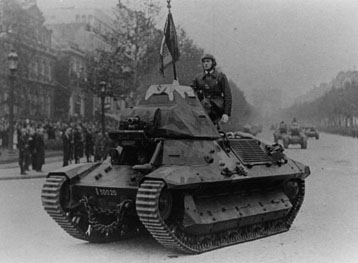|
FCM 36DescriptionThe Forges et Chantiers de la Méditerranée FCM 36 or Char léger Modèle 1936 FCM was a light infantry-support tank that entered service with the French army in May 1938. It was much move expensive that equivalent models from other manufacturers so only 100 were built.
DevelopmentThe development plan of 1926 called for a cheap mass-produced light tank to replace the Renault FT-17. Renault developed the Char D1 to fulfil these requirements, but it was neither cheap nor particularly light (being classed as a medium tank). Following the combined exercises of 1932 and 1933, a plan was created inviting French industry to tender designs. Seventeen companies responded, five submitted prototypes of which three were taken into production: Hotchkiss H 35, Renault R 35 and the FCM 36. Although the FCM 36 was much more expensive than the other two, it was also much more advanced and thus put into production because of its development potential with the idea that it would function as a testbed for further improvements. In March 1934 a wooden mock-up was delivered followed by the first prototypes a year later. Being thought of as a testbed, it had much less urgency than the other two types and the first tank was not delivered until May 1938. The first production run of 100 tanks was completed on March 1939. A future 200 tanks were planned to be ordered but when FCM doubled their already too high price production was halted. The FCM 36 had an advanced welded design with 30mm of armour increased to 40mm by welding an appliqué 10mm armour plate on top of the main armour. Unfortunately the quality of welding proved not to be up to German standards. The armour had a futuristic design with an octaganal turret, the sloped surfaces were very advanced and gave better protection that vertical armour as well as avoiding shot-traps. One of its features which made it attractive to the French military was that it was completely gas-proof. It also had a modern diesel engine instead of the petrol engine used in most French light tanks. This gave it better reliability and a longer operating range. Like the H 35 an R 35, the FCM 36 was armed with the short barrelled 37mm SA18 gun. It is possible that a handful of tanks received the longer 37mm SA 38 gun. OperationThe commander was very overworked in the one-man turret. Apart from directing the driver and keeping in touch with other tanks in his unit (by flags) the commander was also the main gunner and loader. So in action he would have his head in the cupola directing the driver, he would then have to spot the target and jump down into the turret when he would load with the correct ammunition, rotate the turret by hand onto the target, peer through the gun-sight and set the range, finally fire the gun. The driver had a hatch in front of him which was usually left open when the tank moved behind the lines but which would have been suicidal to have open in combat when he relied on an observation slit and a episcope which necessitated detailed instructions from the commander. Both battalions of FCM 36, together with a battalion of R 35 tanks formed there 2nd Army's armoured reserve. The German 1st Panzer Division under Heinz Guderien crossed the Meuse at Sedan on May 13th and formed a bridgehead. The two FCM 36 battalions, each supported by an infantry battalion, counterattacked on the 14th. They encounterred German Panzer III tanks but the poor quality of the French 37mm SA 18 gun meant that they could not penetrate the Panzer III's armour. The thick sloping armour on the FCM 36 meant that the superior 37mm gun on the Panzer III could not penetrate the FCM 36. A slugging match occurred often at point blank range. Finally the appliqué armour on the FCM 36 failed and the French withdrew, out of ammunition and exhausted, leaving 26 tanks behind. They did however buy enough time to allow the 3rd DCR and 3rd DIM to deploy in order to meet the German advance. The French were not helped by their lack of AP shells, the 7th BCC are known to have followed the normal practice for infantry support tanks and only carried 12 rounds of AP. The Germans captured 50 vehicles but they were not at first used. In 1942-43, desperate for tank destroyers, the now famous Alfred Becker mounted 7,5cm PaK 40 anti-tank guns and 10,5 cm leFH 16/18 howitzers on the FCM 36 chassis. These were used by the 21st Panzer Division with great success in Normandy 1944, especially against the British during Operation Goodwood. DeploymentThe FCM 36 light tanks were divided so as to equip two independant tank battalions (BCC). These were unique in that they were also know as light tank battalions: Bataillon de Chars Légèrs (BCL). Tank battalions equipped with other makes of light tanks were not called BCL. 10th May 1940When the Germans's attacked the French army had the following FCM 36 tanks on active service. The remaining 10 tanks were used, five per battalion, as driver training vehicles.
Technical Data
| ||||||||||||||||||||||||||||||||||||||||||||||||||||||||||||


